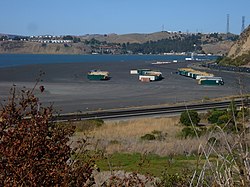Rodeo, California
| Rodeo | |
|---|---|
| Census-designated place | |

Containers beached on the outskirts of Rodeo
|
|
 Location in Contra Costa County and the state of California |
|
| Coordinates: 38°01′59″N 122°16′01″W / 38.03306°N 122.26694°WCoordinates: 38°01′59″N 122°16′01″W / 38.03306°N 122.26694°W | |
| Country |
|
| State |
|
| County | Contra Costa |
| Government | |
| • State Senate | Nancy Skinner (D) |
| • State Assembly | Tim Grayson (D) |
| • U. S. Congress | Mike Thompson (D) |
| Area | |
| • Total | 4.632 sq mi (11.997 km2) |
| • Land | 3.747 sq mi (9.706 km2) |
| • Water | 0.885 sq mi (2.291 km2) 19.1% |
| Elevation | 16 ft (5 m) |
| Population (2010) | |
| • Total | 8,679 |
| • Density | 1,900/sq mi (720/km2) |
| Time zone | PST (UTC-8) |
| • Summer (DST) | PDT (UTC-7) |
| ZIP codes | 94547, 94572 |
| Area code(s) | 510 |
| FIPS code | 06-62490 |
| GNIS feature IDs | 1659538, 2409201 |
Rodeo /roʊˈdeɪ.oʊ/ is a census-designated place (CDP) located in Contra Costa County, California on the shore of San Pablo Bay. The population was 8,679 at the 2010 census. The town is named for the livestock roundups common in the late 19th century. Cattle from the surrounding hills were regularly driven down through the old town to a loading dock on the shoreline of San Pablo Bay for shipment to slaughterhouses, a practice which continued through the early 20th century. The town of Rodeo is served by the Interstate 80 freeway and State Route 4. The Southern Pacific Railroad main line passes through Rodeo. Rodeo has not been a stop on the railroad since the 1950s.
Rodeo owes much of its history to brothers John and Patrick Tormey, who purchased tracts of land from the Ygnacio Martinez Rancho El Pinole estate in 1865 and 1867.
They became successful ranchers and businessmen, amassed sizable fortunes and held public office. Patrick Tormey (for whom the nearby town of Tormey is named) had visions of this area of Contra Costa County becoming the meatpacking and canning center of the Pacific coast. In partnership with the Union Stockyard Co. in 1890, he sold some of the land to them and began to lay out plans and make large investments for the stockyard facilities. Eventually, streets were graded and lots were prepared for homesteads, thus creating the town of Rodeo.
Patrick Tormey also sold land in the nearby town of Oleum to the California Lumber Co. for use as a lumberyard (which eventually would be sold to the Union Oil Co. for an oil refinery site). He also sold land in nearby Selby, which was used by the Selby Smelting & Lead Co. He funded the meatpacking plant, corrals and the Rodeo Hotel.
...
Wikipedia
